Hair loss can significantly impact self-esteem and overall quality of life. For many individuals, hair transplants offer a viable solution to restore a fuller head of hair and boost self-confidence.
This comprehensive guide explores the costs and benefits of hair transplants, helping you make an informed decision about investing in your confidence through this transformative procedure.
Understanding Hair Transplants
A hair transplant is a surgical procedure designed to address hair loss by transferring hair follicles from a donor area (typically the back or sides of the head) to thinning or balding areas.
This procedure can provide natural-looking results and is considered a permanent solution for hair restoration.
Two primary types of hair transplant procedures exist: Follicular Unit Transplantation (FUT) and Follicular Unit Extraction (FUE).
Table of content
Costs of Hair Transplants
Factors Influencing Hair Transplant Costs
The cost of a hair transplant can vary depending on several factors, including:
- Extent of Hair Loss: The number of grafts required for the procedure influences the overall cost. Patients with significant hair loss may need more grafts, increasing the price.
- Type of Procedure: FUT and FUE have different cost structures, with FUE typically being more expensive due to its labor-intensive nature.
- Location of the Clinic: The clinic’s geographic location can impact its cost, with prices varying between cities and countries.
- Experience of the Surgeon: Highly experienced and board-certified plastic surgeons may charge more for their expertise.
- Clinic Reputation: Established clinics with a proven track record of successful hair transplants may have higher fees.
Average Cost of Hair Transplants
The average cost of a hair transplant in the United States can range from $4,000 to $15,000, depending on the abovementioned factors.
You need to consult a reputable clinic for an accurate estimate based on your specific hair restoration needs.
Benefits of Hair Transplants
Permanent Solution
Hair transplants offer a permanent solution to hair loss. Unlike temporary solutions such as special shampoos or platelet-rich plasma (PRP) treatments, hair transplants provide long-lasting results by restoring natural hair growth in thinning areas.
Natural-Looking Results
When performed by an experienced surgeon, hair transplants can achieve natural-looking results that blend seamlessly with your existing hair.
The transplanted hair follicles grow naturally, providing a fuller head of hair and enhancing your overall appearance.
Boost in Self-Esteem and Confidence
Hair loss can significantly impact a person’s self-esteem and mental health. Restoring a full head of hair can boost self-confidence, improve self-assurance, and positively affect various aspects of life, including personal relationships and professional opportunities.
Low Maintenance Solution
Once the transplanted hair follicles are established, they require minimal maintenance. Unlike other hair loss treatments that necessitate ongoing care and attention, hair transplants offer a low-maintenance solution for a fuller head of hair.
Suitable for Various Types of Hair Loss
Hair transplants can address different types of hair loss, including male pattern baldness, alopecia areata, and hair thinning due to hormonal changes or medical conditions.
This versatility makes hair transplants a viable solution for many patients.
Minimal Downtime
FUE hair transplants, in particular, offer minimal downtime compared to other surgical procedures. Most patients can return to their normal activities within a few days, making it a convenient option for those with busy lifestyles.
Preparing for a Hair Transplant
Thorough Research
Before undergoing hair transplant surgery, it is crucial to conduct thorough research. Understand the different types of procedures, costs involved, and potential benefits. Consult with multiple clinics to compare their offerings and choose the best suits your needs.
Choosing an Experienced Surgeon
Selecting a skilled and experienced surgeon is critical to achieving successful results. Look for a board-certified plastic surgeon with a proven track record in hair transplantation. Reviews and testimonials from previous patients can provide valuable insights into the surgeon’s expertise.
Understanding the Procedure
Discuss the details of the procedure with your surgeon during the initial consultation. Understand the number of grafts required, the expected outcome, and the recovery process. This knowledge will help you set realistic expectations and prepare mentally and physically for the surgery.
The Hair Transplant Procedure
Day of Surgery
On the day of the surgery, you will be given local anesthesia to numb the donor and recipient areas. This ensures a pain-free experience during the procedure.
The surgeon will then perform the transplant technique (FUT or FUE), which can take several hours, depending on the number of grafts required.
Post-Operative Care
Following the surgery, you will receive specific instructions for post-operative care. This may include:
- Avoid strenuous activities to prevent dislodging the grafts.
- Keeping the scalp clean and following a gentle hair care routine.
- Taking prescribed medications to manage pain and prevent infection.
Recovery Process
The recovery process varies depending on the individual and the type of procedure performed. Most patients experience swelling and redness in the first few days, which should subside within a week.
The transplanted hair may shed within the first few weeks, but new hair growth typically begins within three to four months.
Achieving Natural-Looking Results
The final results from a hair transplant can take up to a year to fully manifest. The transplanted hair will continue to grow and thicken over time, blending seamlessly with your existing hair and providing a natural appearance.
Potential Complications and Risks
Inherent Risks
As with any surgical procedure, hair transplants carry inherent risks, including infection, bleeding, and scarring. Choosing an experienced surgeon and following post-operative care instructions can minimize these risks.
Managing Expectations
It’s essential to have realistic expectations about the outcome of the hair transplant. While the procedure can significantly improve hair density and appearance, it may not completely restore a full head of hair in cases of extensive hair loss.
Consulting with Your Surgeon
Discuss any concerns or potential complications with your surgeon during the consultation. They can provide detailed information about the risks and how to mitigate them.
Comparing Hair Transplants to Other Hair Loss Treatments
Temporary Solutions
Temporary solutions for hair loss, such as special shampoos, topical treatments, and PRP therapy, can provide short-term benefits but require ongoing maintenance.
These treatments may not address the root cause of hair loss and can become costly.
Permanent Solution
Hair transplants permanently solve hair loss by restoring natural hair growth in thinning areas. This long-term benefit makes hair transplants a cost-effective option compared to temporary treatments.
Overall Quality of Life
Restoring a full head of hair can enhance your overall quality of life, boosting self-confidence and improving mental health. The psychological benefits of hair transplants often outweigh the initial investment, making it a worthwhile consideration for many individuals.
Conclusion

Investing in your confidence through a hair transplant can provide numerous benefits, including natural-looking results, a permanent solution to hair loss, and a significant boost in self-esteem.
While the cost of a hair transplant may vary depending on several factors, the long-term advantages make it a worthwhile investment for those seeking to restore their hairline and overall appearance.
By conducting thorough research, choosing an experienced surgeon, and understanding the procedure and recovery process, you can achieve successful outcomes and enjoy the benefits of a fuller, healthier head of hair.
Whether dealing with minor hair thinning or significant hair loss, a hair transplant offers a viable and transformative solution to enhance your appearance and confidence.
FAQs
1. What is a hair transplant?
A hair transplant is a surgical procedure designed to address hair loss by transferring hair follicles from a donor area (typically the back or sides of the head) to thinning or balding areas. This procedure can provide natural-looking results and is considered a permanent solution for hair restoration.
How much does a hair transplant cost?
The cost of a hair transplant can vary depending on several factors, including the extent of hair loss, the type of procedure (FUT or FUE), the clinic’s location, and the surgeon’s experience. On average, hair transplants in the United States can range from $4,000 to $15,000.
3. What are the differences between FUT and FUE?
FUT (Follicular Unit Transplantation) involves removing a strip of skin from the donor area, which is then dissected into individual hair follicles and transplanted to the recipient area. It allows transplanting many grafts in one session but leaves a linear scar.
FUE (Follicular Unit Extraction) involves extracting individual hair follicles directly from the donor area and transplanting them to the recipient area. It is a minimally invasive technique with no linear scarring and generally has a shorter recovery time.
4. How do I choose an experienced surgeon?
Look for a board-certified plastic surgeon with a proven track record in hair transplantation. Read reviews and testimonials from previous patients, check their credentials, and ask for before-and-after photos of previous procedures. Consult with multiple clinics to compare their offerings and expertise.
5. Is a hair transplant a permanent solution?
Yes, hair transplants offer a permanent solution to hair loss. The transplanted hair follicles are typically resistant to the hormone responsible for hair loss (DHT), ensuring long-lasting results.
6. What should I expect during the recovery process?
Most patients experience some swelling and redness in the first few days after surgery, which should subside within a week. The transplanted hair may shed within the first few weeks, and new hair growth typically begins within three to four months. Final results can take up to a year to fully manifest.
7. Are there any risks or complications associated with hair transplants?
As with any surgical procedure, hair transplants carry inherent risks, including infection, bleeding, and scarring. Choosing an experienced surgeon and following post-operative care instructions can minimize these risks. Discuss any concerns with your surgeon during the consultation.
8. How long does the hair transplant procedure take?
The duration of the hair transplant procedure can vary depending on the number of grafts being transplanted and the technique used. Generally, the procedure can take several hours. Your surgeon will provide a more accurate time estimate during your initial consultation.
9. When can I return to work after a hair transplant?
Most patients can return to work within a few days to a week after the procedure, depending on the nature of their job and how they feel. Your surgeon will provide specific recommendations based on your case and recovery progress.
10. Can women undergo hair transplant surgery?
Yes, women can undergo hair transplant surgery. The procedure suits both men and women experiencing hair loss for various reasons, including genetic factors, hormonal changes, or medical conditions.
11. How many hair grafts will I need?
The number of hair grafts needed depends on the extent of your hair loss and your desired results. Your surgeon will determine the exact number of grafts required during the initial consultation based on a thorough hair and scalp assessment.
12. Will the transplanted hair look natural?
Hair transplants can achieve natural-looking results when performed by an experienced surgeon. The surgeon will carefully plan the transplanted hair’s angle, direction, and density to ensure it blends seamlessly with your existing hair.
13. How do I prepare for a hair transplant?
Preparing for a hair transplant involves several steps, including quitting smoking at least two weeks before and after the surgery, avoiding blood thinners and certain medications, and following a healthy diet. Your surgeon will provide specific pre-operative instructions during your consultation.
14. Is hair transplant surgery painful?
The hair transplant procedure is performed under local anesthesia, which numbs the donor and recipient areas, ensuring a pain-free experience during the surgery. Some discomfort and soreness may be experienced during recovery, but this can be managed with prescribed medications.
15. What are the alternatives to hair transplants?
Alternatives to hair transplants include temporary solutions such as special shampoos, topical treatments, and platelet-rich plasma (PRP) therapy. While these treatments can provide short-term benefits, they require ongoing maintenance and may not address the root cause of hair loss as effectively as a hair transplant.
Zoom Clinic clients before and after hair transplantation
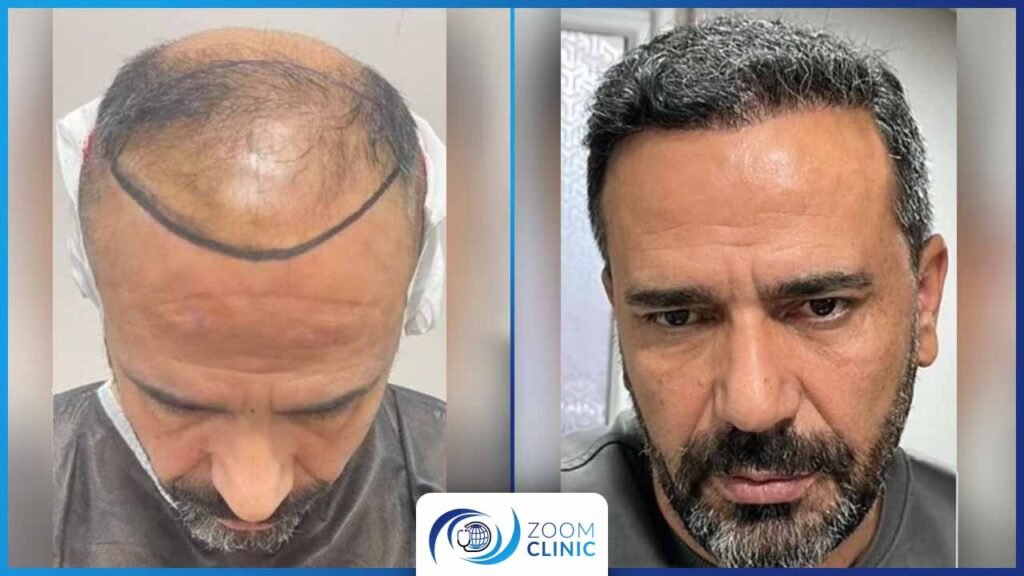
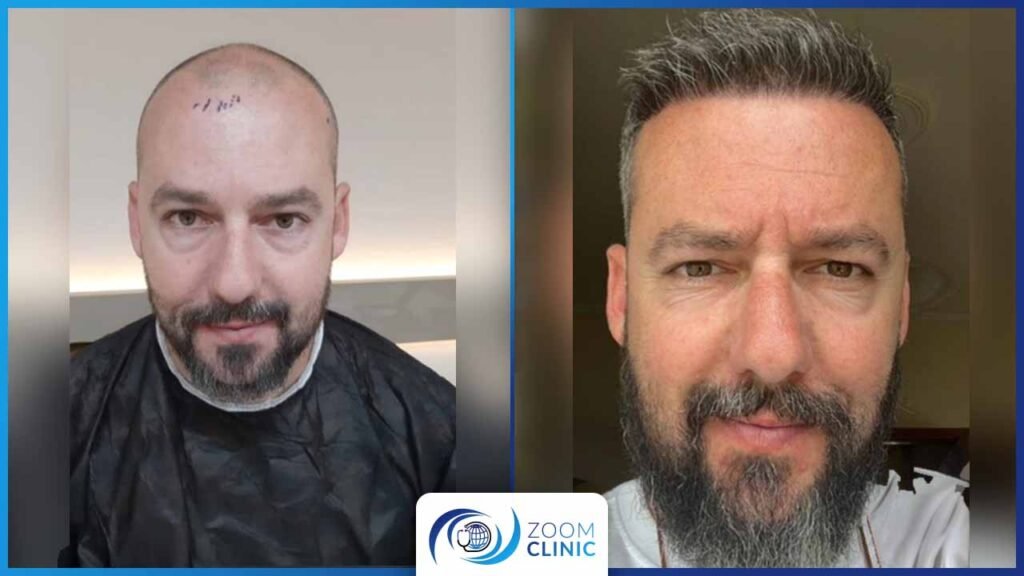
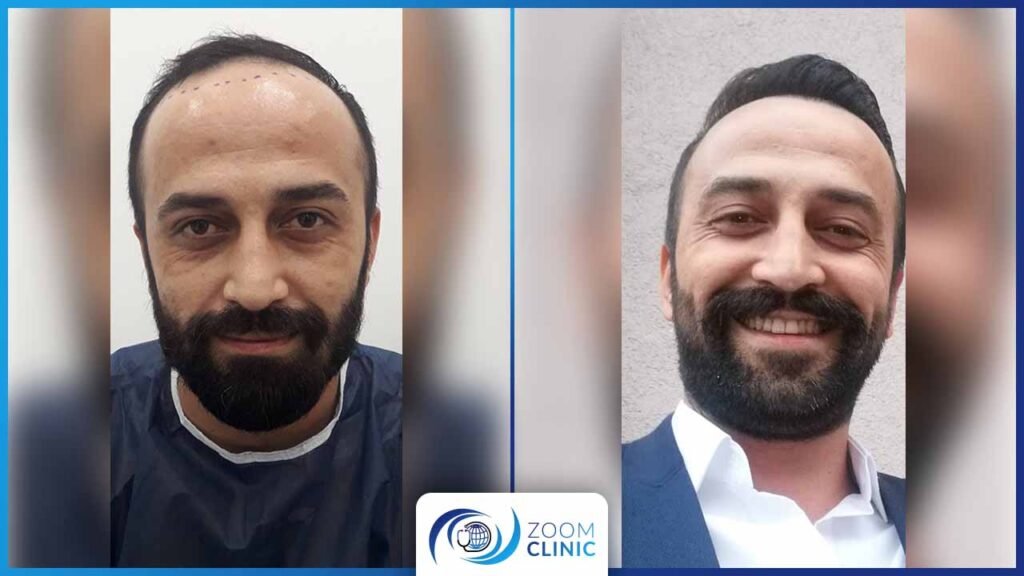
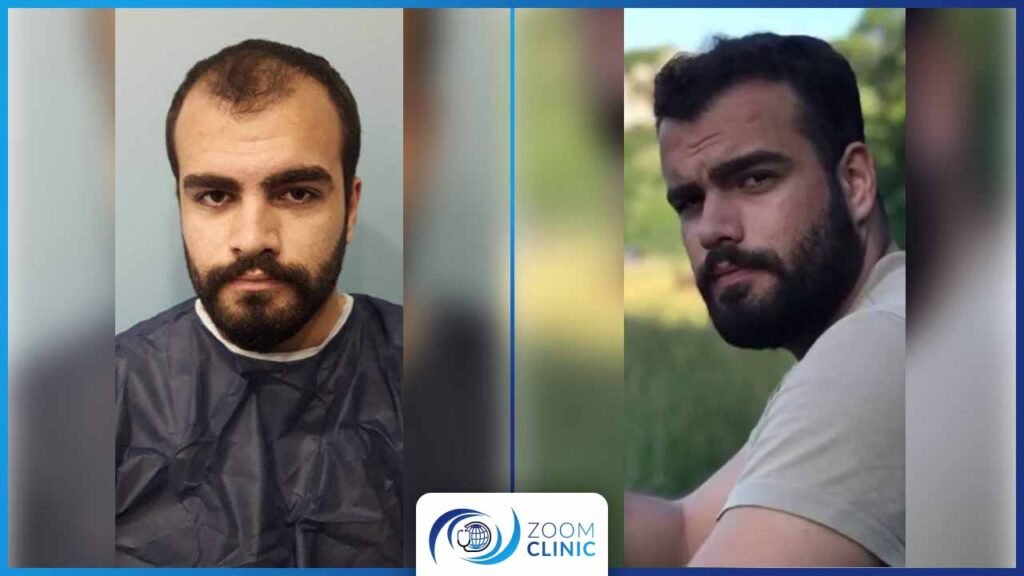
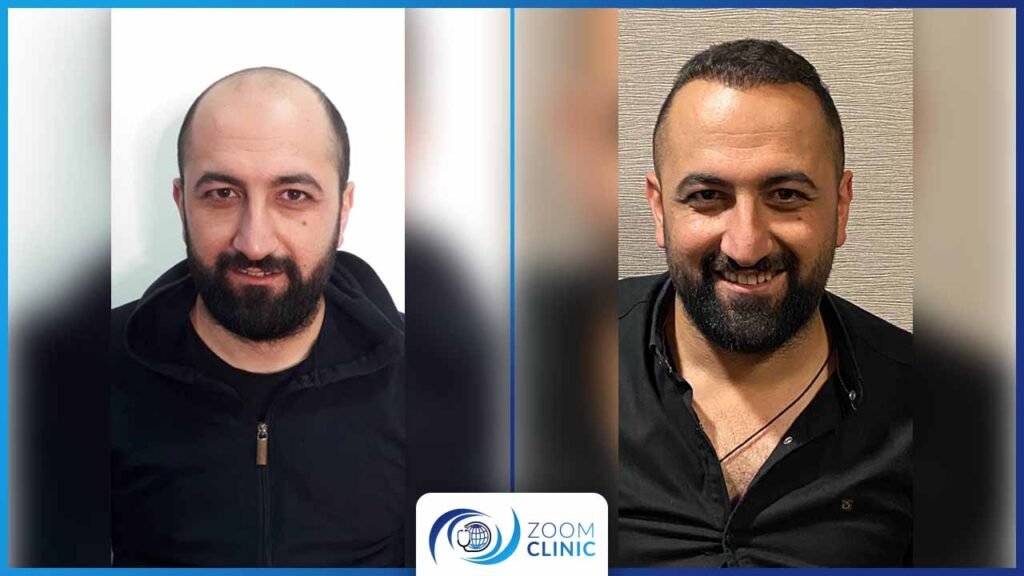
Get the special offer today from Zoom Clinic
Read Also:
Understanding Hair Growth Cycles


